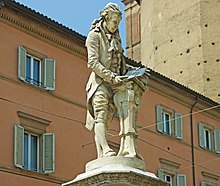Luigi Galvani
Luigi Aloisio Galvani (born September 9, 1737 in Bologna , Italy ; † December 4, 1798 ibid) was an Italian doctor, anatomist and naturalist (especially biophysicist ). Giovanni Aldini was his nephew.
Life
Galvani initially studied theology and later medicine in Bologna, where he graduated in 1759. The applause that his treatise De renibus atque ureteribus volatilium of 1767 found, led him to the decision to work on the physiology of birds; but later he limited himself to examining their auditory organs.
A coincidence led him to the discovery of galvanism , named after him, on November 6, 1780 , which Emil du Bois-Reymond reported in the first volume of his investigations on animal electricity (Berlin 1848).
Galvani discovered through experiments with frogs' legs the contraction of muscles when they came into contact with copper and iron, whereby copper and iron must also be connected. So Galvani unknowingly created a circuit consisting of two different metals, an electrolyte (“salt water” in the frog's legs) and a “current indicator” (muscle). Galvani did not yet recognize these connections, but he laid the foundation for the development of electrochemical cells (also called galvanic cells or galvanic elements) by Alessandro Volta .
Galvani noticed that a frog's leg that was in contact with a knife blade always winced when a spark jumped over a nearby high-voltage machine. He was convinced - also due to the famous lightning conductor experiments made by Benjamin Franklin a few decades earlier - that thunderstorm lightning is in principle also such sparks, only much larger. So he led an insulated wire from the ridge of a house in the garden to a frog's leg. A second wire led from this into a well. Whenever lightning flashed in the vicinity of a thunderstorm, the frog's leg started to move and this before the associated thunder could be heard.
During the reign of terror of the French Revolution , Galvani refused to take an oath on the new government. He then lost his office through the welfare committee , in which he was reinstated after 1794.
Honors
In 1875 the city of Bologna held a competition for a statue of Luigi Galvanis. The winner was the sculptor Adalberto Cencetti , who completed this work in 1879.
Which were named after him electroplating , the galvanometer , the galvanotaxis , the Galvani potential the Galvano , the asteroid (10184) Galvani and the lunar crater Galvani .
Works
- De renibus atque urethris volatilium
- Aloisius Galvani: Treatise on the forces of electricity in muscle movement (Comm. Bonon. Sc. Et Art. Inst. Et Acad. T. 7; 1791, original title: De viribus electricitatis in motu musculari commentarius ), edited by AJ von Oettingen, 2nd ed., Repr. Of the ed. Leipzig, Engelmann, 1894 and 1900. German, Thun / Frankfurt am Main 1996, ISBN 3-8171-3052-X (also contains: Alessandro Volta : Studies on Galvanism (1796–1800 ), earlier than: Ostwald's Classics of Exact Sciences ; Volumes 52 and 118).
- Opere edite ed inedite del Prof. Luigi Galvani . Dall'Olmo, Bologna 1841-1842
literature
- Jean L. Alibert: Éloge historique de Galvani. Ravier, Paris 1806.
- Marcello Pera : The ambiguous frog. The Galvani-Volta controversyon animal electricity. Princeton University Press, Princeton NJ 1992, ISBN 0-691-08512-9 .
- Manfred Wenzel: Galvani, Luigi Aloisio. In: Werner E. Gerabek , Bernhard D. Haage, Gundolf Keil , Wolfgang Wegner (eds.): Enzyklopädie Medizingeschichte. De Gruyter, Berlin / New York 2005, ISBN 3-11-015714-4 , p. 455.
- Sergio Züllig: Luigi Galvani (1732–1798). Discoverer of bioelectricity. Dissertation at the medical faculty of the University of Basel in 1969, DNB 571649726 .
Web links
- Literature by and about Luigi Galvani in the catalog of the German National Library
- Short biography and bibliography (English) in the Virtual Laboratory of the Max Planck Institute for the History of Science
- Corrosion Doctors
supporting documents
- ↑ in: De Bononiensi Scientiarum et Artium Instituto Commentarii 1767. TV Il. Pp. 500-508, cit. after Shocking Frogs: Galvani, Volta, and the Electric Origins of Neuroscience - Marco Piccolino, Marco Bresadola
- ↑ leifiphysik.de, Basic electrical parameters: Frogs Galvanis
| personal data | |
|---|---|
| SURNAME | Galvani, Luigi |
| ALTERNATIVE NAMES | Galvani, Luigi Aloisio (full name) |
| BRIEF DESCRIPTION | Italian physician, anatomist and biophysicist |
| DATE OF BIRTH | September 9, 1737 |
| PLACE OF BIRTH | Bologna , Italy |
| DATE OF DEATH | December 4, 1798 |
| Place of death | Bologna , Italy |


